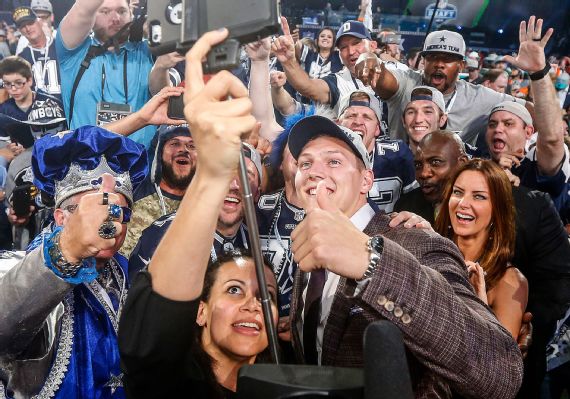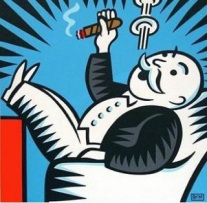
W.J. Astore
Nothing screams “USA!” like the NFL draft held yearly at the end of April, and I managed to watch a few minutes here and there across the three days of blanket coverage offered by ESPN and the NFL network (I also noticed the draft was in prime time on the Fox network). The National Football League (NFL) puts on an extravaganza for the draft. This year I caught a ceremony featuring the family of dead soldier; they “helped” to make a pick in the draft for the Dallas Cowboys. The huge video screen featured the soldier (Captain Ellery Ray Wallace) who’d been killed, and the fans in the dome started chanting “USA! USA!” in homage to a man who must have loved the Cowboys when he was alive. The spectacle of it all just made me sad, no matter how much the NFL tried to sell this and similar photo ops as exercises in helping grieving families to recover from the tragedy of losing a loved one in war.
As I wrote about last year’s draft, “I’m always dazed and amazed by the sheer work that goes into the NFL draft: the thoroughness of it all, the expertise on display, the active and informed involvement of the fans. Imagine if ESPN (or any media outlet, for that matter) covered America’s wars with the same commitment to detail and facts as is displayed yearly for American football!”
And as I wrote about the NFL draft two years ago:
If you’re not familiar with NFL football or ESPN coverage of the same in the USA, you should be, because it says much about the American moment. The first round of the draft kicks off on Thursday night in prime time, followed by the second and third rounds on Friday night in prime time. The draft concludes on Saturday with rounds four through seven, roughly 250 total picks …
Yet this quick summary vastly understates the coverage devoted to the draft. From the end of the Super Bowl early in February to the draft itself at the end of April, coverage of the draft on ESPN is virtually non-stop, with innumerable “mock” drafts for each team and a parade of “experts” speculating about the prospects of each player and team. Exhaustive (and exhausting) is the word to describe this coverage. Interminable is another one.
When Round One finally kicks off, it’s essentially a parade of soon-to-be millionaires. These players, selected from various college football teams, can count on multi-year contracts and signing bonuses in the millions of dollars. ESPN and the NFL stage manages the selection process, turning it into an extravaganza complete with musicians, cheering (or booing) fans, and plenty of past NFL greats, along with the draftees and their families and friends. Coverage also includes shots of the “war rooms” of the various NFL teams as they decide which players to pick, which draft picks to trade, and so on.
The war room — isn’t that a telling phrase?
Indeed, let’s push that further. Most red-blooded NFL fans would be hard-pressed to find Iraq or Afghanistan on a map, but they can tell you all about their team’s draft picks, rattling off statistics such as times in the 40-yard dash, vertical leap, even the size of a player’s hands (considered especially pertinent if he’s a quarterback or wide receiver). What always astonishes me is the sheer wealth of detail gathered about each player, the human intelligence (or HUMINT in military terms). Players, especially those projected to go in the first few rounds, are scrutinized from every angle: physical, mental, emotional, you name it.
With millions of dollars at stake, such an exhaustive approach is not terribly surprising. Yet even with a wealth of data, each year there are major draft busts (e.g. Ryan Leaf, selected #2 overall in the first round and a flop) and major surprises (e.g. Tom Brady, selected late in the 6th round as the 199th pick, meaning that not much was expected from him, after which he won four [now five] Super Bowls). Results from the NFL draft should teach us something about the limits of data-driven “intelligence” in “wars,” yet our various military intelligence agencies continue to believe they can quantify, predict, and control events.
But again what wows me is the extent as well as the slickness of ESPN’s coverage of the draft. As soon as a player is selected, ESPN instantly has video of that player’s college highlights, together with his vital statistics (height, weight, performance at the draft combine in various drills, and so on). Video and stats are backed up by interviews with a draftee’s previous coaches, who extol his virtues, along with interviews with those “war rooms” again as to why they decided to draft that particular player and not another. Once the draft is completed, teams are then awarded “grades” by various commentators, even though these players have yet to play a snap in the NFL. (Imagine if your kid received an instant grade in college — before he attended a single class or completed a single assignment — based upon his performance in high school.)
But you have to hand it to ESPN: their coverage of the draft is an exercise in total information awareness. It’s blanket coverage, an exercise in full-spectrum dominance. It’s slick, professional, and driven by a relentless pursuit of victory by each team (and a relentless pursuit of ratings by ESPN).
In 2016, I made the following proposal, in jest of course, but I repeat it here because I still think it’s telling:
Let’s put ESPN in charge of intelligence gathering and coverage [of America’s wars]. Just imagine if your average red-blooded American devoted as much attention to foreign wars as they do to their favorite NFL team! Just imagine if America’s leaders were held accountable for poor results as NFL coaches and staffs are! America still might not win its wars, but at least we’d squarely face the fact that we’re continuing to lose at incredibly high cost. Indeed, someone high-up in the government might actually be held accountable for these losses.
I know: It’s a frivolous suggestion to treat war like a sport. But is it? After all, America currently treats the NFL draft with all the seriousness of a life-and-death struggle, even as it treats wars with comparative frivolity.
Our wars are games and our games are wars. Small wonder America continues to lose its wars while fielding some winning NFL teams.




